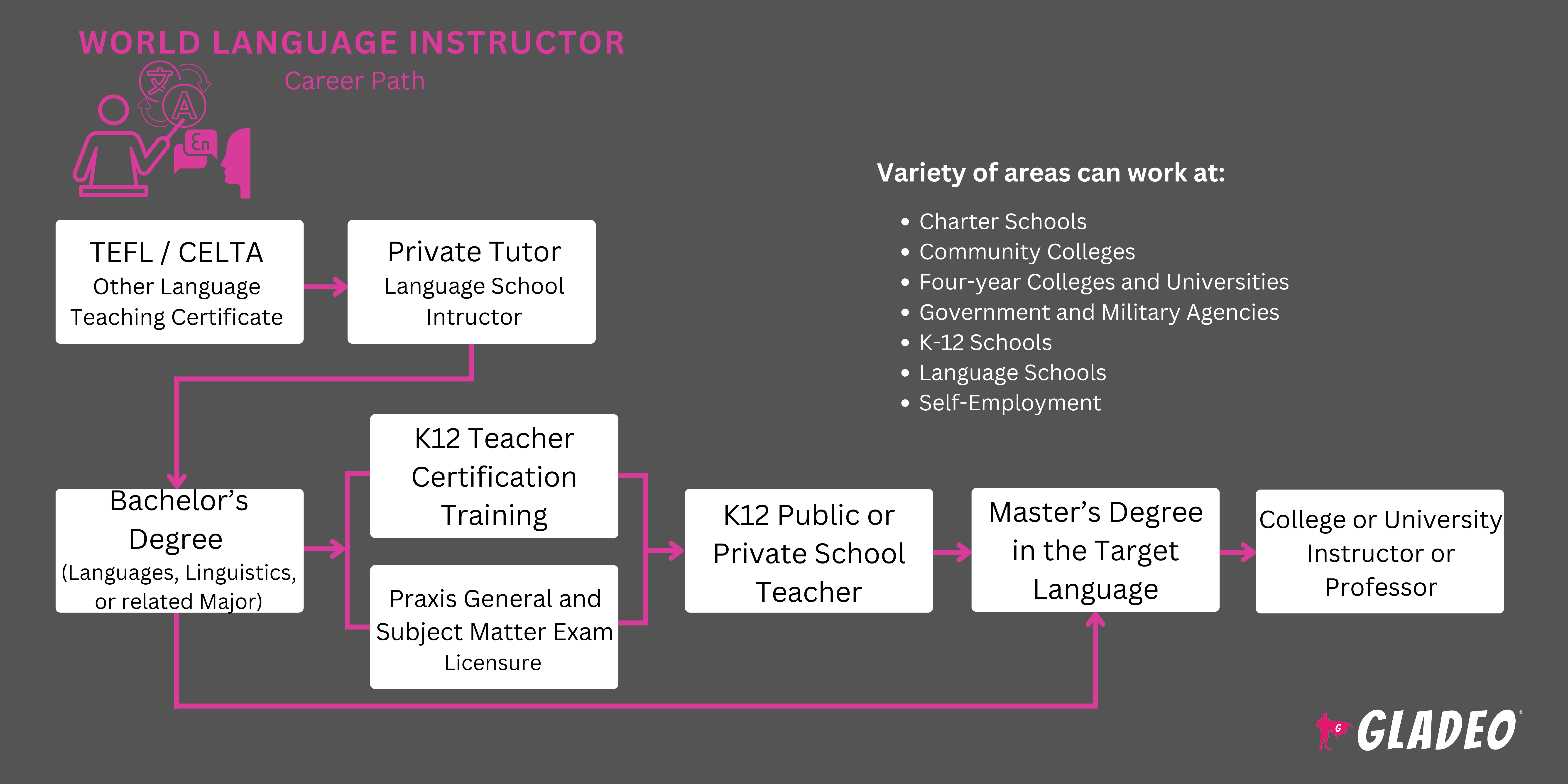Mga spotlight
Assistant Professor, Associate Professor, Foreign Languages Professor, French Professor, German Professor, Instructor, Modern Languages Professor, Propesor, Spanish Instructor, Spanish Professor
Mayroong ~7,000 wikang sinasalita sa mundo, at ~43% ng populasyon ay nagsasalita ng hindi bababa sa dalawa sa kanila. Marami ang pinalaki sa mga bilingual na sambahayan o nalantad sa maraming wika sa kanilang mga komunidad. Ang iba ay natututo sa pamamagitan ng pagkuha ng mga pormal na kurso sa wika bilang elective o libangan sa paaralan o upang maghanda para sa paglalakbay sa ibang bansa. Ang mga kursong ito sa wika ay karaniwang itinuturo ng isang sinanay na Tagapagturo ng Wika!
Nagtatrabaho ang mga World Language Instructor sa mga K-12 na paaralan, kolehiyo, at espesyal na paaralan ng wika. Ang ilan ay nagtatrabaho nang nakapag-iisa bilang mga pribadong tagapagturo. Ang kanilang trabaho ay tulungan ang mga mag-aaral na makakuha ng mga bagong kasanayan sa wika na kapaki-pakinabang para sa komunikasyon pati na rin ang mas mahusay na pang-unawa sa kultura. Una, tinutukoy nila ang kasalukuyang antas ng kasanayan ng kanilang mga target na mag-aaral, pagkatapos ay bumuo ng mga malikhaing plano ng aralin, magturo ng mga aralin nang personal o online, pinapadali ang mga talakayan at aktibidad sa silid-aralan, at tinatasa ang pag-unlad sa pamamagitan ng mga pagsusulit at takdang-aralin.
Depende sa kanilang sariling kasanayan, ang mga instruktor ay maaaring magturo lamang ng ilang mga antas, gaya ng mga kursong beginner, intermediate, o advanced. Sa pangkalahatan, ang kanilang layunin ay tulungan ang mga mag-aaral na matuto kung paano magsalita, makinig, magbasa, magsulat, at mag-isip sa pangalawang wika. May mga partikular na layunin ang ilang klase tulad ng pagpapabuti ng mga kasanayan sa grammar at komposisyon, pagbabawas ng accent, o pagbuo ng bokabularyo ng negosyo sa bagong wika.
- Ang pagsaksi sa estudyante ay nagpapabuti sa kanilang kahusayan sa bagong wika
- Pagsusulong ng kamalayan at pang-unawa sa kultura
- Mga pagkakataong magtrabaho sa magkakaibang mga setting ng edukasyon
- Pakikipag-ugnayan sa mga mag-aaral mula sa iba't ibang background at kultura
Oras ng trabaho
Ang mga World Language Instructor ay maaaring magtrabaho nang buo o part-time depende sa kanilang sitwasyon sa trabaho. Maaaring kabilang sa mga oras ang gabi o katapusan ng linggo. Kapag hindi sila nagtuturo, kailangan nilang gumugol ng oras sa paghahanda para sa paparating na mga aralin o mga takdang-aralin sa pagmamarka.
Mga Karaniwang Tungkulin
- Pumili o magdisenyo ng kurikulum na angkop sa antas ng mag-aaral o silid-aralan. Pumili ng angkop na mga aklat-aralin at workbook.
- Gumawa ng lesson plan para sa buwan, termino, o taon. Ipalaganap ang syllabi, kung kinakailangan.
- Maghanda ng mga aralin kabilang ang mga handout, materyales, takdang-aralin, o pagsusulit. Pumili ng iba't ibang materyales upang mapanatili ang atensyon ng mga mag-aaral.
- Magturo ng mga aralin at hikayatin ang mga mag-aaral na lumahok. Magbigay ng mga paraan para sa mga mag-aaral na magsanay ng mga kasanayan sa pagtanggap (tulad ng pagbabasa at pakikinig) at mga produktibong kasanayan tulad ng pagsasalita at pagsulat.
Mag-isyu ng mga takdang-aralin na may takdang petsa. Markahan at magkomento sa mga takdang-aralin. - Magbigay ng mga pagsusulit at pagsusulit. Suriin at bigyan ng marka ang mga pagsusulit na ito.
- Panatilihin ang mga talaan ng pagdalo at mga talaan ng grado. Maglagay ng impormasyon sa mga database o mga sistema ng pamamahala ng pag-aaral .
- Subaybayan ang pag-unlad ng mag-aaral at suportahan ang mga mag-aaral na nahihirapan sa isang paksa o lugar.
- Ayusin ang mga paraan ng pagtuturo kung kinakailangan upang matugunan ang mga pangangailangan sa pagkatuto ng mag-aaral.
- Magtatag ng pare-parehong oras ng opisina upang makipagkita at payuhan ang mga mag-aaral nang isa-isa. Maglingkod sa mga komite ng paaralan upang magbahagi ng mga opinyon tungkol sa mga patakaran, problema, at mga usapin ng departamento.
- Kumilos bilang tagapayo sa mga grupo ng mag-aaral na may kaugnayan sa wika.
- Makipagtulungan sa mga paaralan, mag-aaral, at magulang para mapadali ang mga programa sa paglulubog o pag-aaral sa ibang bansa.
Karagdagang Pananagutan
- Manatiling nakasubaybay sa mga pag-unlad sa mga teknolohiya at pedagogy para sa pagtuturo sa mga nag-aaral ng wika.
- Makipagtulungan sa mga kasamahan sa pagbuo ng kurikulum.
- Sumulat ng nilalaman para sa mga webpage na nauugnay sa mga kursong itinuturo.
- Tulungan ang mga mag-aaral na maghanda para sa mga pagsusulit sa kasanayan sa wika tulad ng TOEFL o IELTS .
Soft Skills
- Kakayahang umangkop
- Pakikipagtulungan
- Pagkamalikhain
- Sensitibo sa kultura
- Pagnanais at kakayahan na tulungan ang iba na magtagumpay
- Empatiya
- Sigasig
- Mga kasanayan sa interpersonal
- Matalas na kasanayan sa organisasyon
- pasensya
- Katatagan at katatagan
- Tamang paghuhusga at paggawa ng desisyon
- Malakas na kasanayan sa komunikasyon
- Pamamahala ng oras
Teknikal na kasanayan
- Kahusayan sa target na wika na angkop sa antas na itinuturo
- Kakayahang suriin at gabayan ang pag-uugali ng mag-aaral
- Pamamahala ng silid-aralan at mga diskarte sa pakikipag-ugnayan ng mag-aaral
- Kultural na kamalayan at integrasyon sa pagtuturo ng wika
Pagbuo ng kurikulum - Pamilyar sa mga pagsusulit sa kasanayan sa wika tulad ng IELTS at TOEFL
Mga app at software sa pag-aaral ng wika - Pagsasanay sa pagbigkas at kadalubhasaan sa phonetics
- Mga kasanayan para sa koordinasyon at pagtuturo ng mga aktibidad
- Pag-unawa sa pedagogy sa pagtuturo ng wika
- Paggamit ng teknolohiyang pang-edukasyon tulad ng mga sistema ng pamamahala sa pag-aaral
- K-12 na paaralan
- Mga paaralang charter
- Mga kolehiyong pangkomunidad
- Apat na taong kolehiyo at unibersidad
- Mga paaralan ng wika
- Mga ahensya ng gobyerno at militar
- Sariling hanapbuhay
Ang mga World Language Instructor ay inaasahang mapanatili ang isang mataas na antas ng kasanayan sa wika at manatiling updated sa mga pang-edukasyon na pinakamahusay na kasanayan. Hindi lahat ng instructor ay may hawak na tradisyonal na mga lisensya sa pagtuturo o mga kredensyal, na maaaring limitahan ang kanilang mga opsyon sa trabaho. Halimbawa, para magturo sa pampublikong K-12 system, kailangang matugunan ng mga manggagawa ang ilang mga kinakailangan sa pagsasanay at lisensya. Upang magturo sa isang kolehiyo, maaaring kailanganin ng isa ang master's degree. Gayunpaman, upang magturo sa isang paaralan ng wika o bilang isang pribadong tutor, maaaring walang mahirap na mga kinakailangan upang matugunan.
Para sa mga nagtatrabaho sa mga paaralan o kolehiyo ng K-12, maaaring may mga karagdagang responsibilidad tulad ng paglilingkod sa mga komite o pagtulong sa mga aktibidad na nauugnay sa paaralan. Ang mga pahinga sa tag-init ay kadalasang nagreresulta sa ilang linggo mula sa pagtuturo, na maaaring makaapekto sa mga suweldo para sa ilang mga instruktor.
Ang mga pamamaraan at kurso sa pag-aaral ng wika tulad ng Berlitz, Pimsleur, at Rosetta Stone ay nakatulong sa pagbibigay daan para sa kasaganaan ng mga bagong programa at app sa merkado ngayon. Ngayon ang mga mag-aaral ay maaaring matuto on the go sa pamamagitan ng mga mobile app tulad ng Duolingo, Babbel, Memrise, Busuu, at dose-dosenang higit pa.
Sa ilang lawak, ang paglaganap ng madaling gamitin, medyo abot-kayang mga opsyon na ito ay nakaapekto sa mga oportunidad sa trabaho para sa mga World Language Instructor. Bilang karagdagan, ang pagtaas at pagtaas ng pagiging sopistikado ng mga instant na programa sa pagsasalin ay ginagawang mas madali ang pakikipag-usap sa ibang mga wika nang hindi na kailangang matutunan ang mga ito.
Sa halip na balewalain ang mga tool na ito, ang mga tech-savvy na World Language Instructor ay isinasama ang mga ito sa kanilang mga silid-aralan at mga kapaligiran sa pag-aaral, gamit ang mga ito upang madagdagan ang kanilang sariling gawain. Maaaring makinabang ang mga mag-aaral mula sa pinaghalong live na pagtuturo at pagsasanay sa mga online na programa, na ginagawang mas nakakaengganyo at naa-access ang pag-aaral.
Ang mga paraan ng pagtuturo ng wikang komunikatibo ay humuhubog din sa modernong pagtuturo, na binibigyang-diin ang pakikipag-ugnayan sa totoong buhay kaysa sa pagsasaulo. Ang praktikal na diskarte na ito ay hinihikayat ang mga mag-aaral na aktibong gamitin ang target na wika sa mga makabuluhang paraan habang tinutulungan silang malampasan ang "pagkaasiwa" na maaaring maramdaman nila mula sa paggawa ng mga pagkakamali habang naglalakad.
Minsan lumaki ang mga World Language Instructor sa mga bilingual na sambahayan – o nasiyahan lang sila sa pag-aaral tungkol sa ibang mga kultura at bagong wika. Bilang mga guro, madalas silang maging palakaibigan at sabik na tulungan ang iba na matuto. Ang mga ito ay kadalasang likas na katangian na maaaring nabuo nila sa bahay o sa paaralan.
- Ang mga kinakailangan sa edukasyon para sa mga World Language Instructor ay nag-iiba-iba batay sa kanilang pagtatrabaho. Halimbawa:
- Ang mga pribadong tutor na nagtatrabaho para sa kanilang sarili ay walang anumang mahirap na pangangailangan.
- Ang mga tutor na nagtatrabaho sa isang kumpanya (tulad ng isang paaralan ng wika) ay maaaring mangailangan ng kahit man lang diploma sa mataas na paaralan o katumbas, patunay ng kahusayan sa target na wika, at isang sertipikasyon ng ilang uri (tulad ng Sertipiko sa Pagtuturo ng Espanyol bilang Wikang Banyaga ) , depende sa gusto ng employer.
- Ang mga guro ng pribadong charter school ay maaaring mangailangan ng bachelor's degree. Mas gusto ang lisensya o karanasan.
- Ang mga guro ng pampublikong K-12 na paaralan ay nangangailangan ng bachelor's degree at lisensya ng estado o sertipikasyon para magturo. Dapat nilang tapusin ang isang programa sa pagtuturo sa kolehiyo, kumpletuhin ang isang pagsusuri sa background, at pumasa sa dalawang pagsusulit - isang pangkalahatang pagsusulit sa pagtuturo at isang pagsusulit sa paksa.
• Kasama sa mga pangkalahatang pagsusulit sa pagtuturo ang Praxis Core (pinamamahalaan ng ETS) at National Evaluation Series (pinamamahalaan ni Pearson). Nag-aalok din ang mga organisasyong ito ng mga pagsusulit sa paksa para sa iba't ibang wika.
- Ang mga instruktor at propesor sa antas ng kolehiyo ay karaniwang mayroong master's o PhD na may kaugnayan sa target na wika.
- Hindi lahat ng World Language Instructor ay nangangailangan ng degree sa kolehiyo. Dapat isaalang-alang ng mga pipiliin na ituloy ang isa kung saan nila gustong magtrabaho, upang matukoy ang pinakaangkop na major.
- Ang mga guro ng K-12 ay dapat humingi ng mga undergraduate na programa na nagtatampok ng mga ruta ng sertipikasyon ng guro.
- Ang mga gustong magturo sa antas ng kolehiyo ay dapat magplano nang maaga para sa angkop na mga programa sa pagtatapos, na nakatuon sa mga advanced na kasanayan sa wika, panitikan, kultura, at linggwistika.
- Maghanap ng mga akreditadong programa na may mga kilalang miyembro ng faculty at mga pagkakataon para sa pag-aaral sa ibang bansa at kasanayan sa wika.
- Ihambing ang matrikula at iba pang mga gastos sa pagitan ng mga paaralan upang matiyak na nakukuha mo ang pinakamahusay na halaga para sa iyong pera.
- Ihambing ang mga online, on-campus, at hybrid na mga programa upang makahanap ng angkop na opsyon para sa iyong pamumuhay.
- Tingnan ang mga istatistika ng pagtatapos at paglalagay ng trabaho.
- Magpasya kung anong antas ng kasanayan ang gusto mong ituro (beginner, intermediate, o advanced) at ang pangkat ng edad na gusto mong turuan (mga bata, middle schooler, high school students, college students, o adult learner).
- Piliin ang mga setting kung saan mo gustong magturo, tulad ng sa isang pampublikong K-12 na paaralan, isang charter school, isang kolehiyo, isang pribadong paaralan ng wika o kumpanya, o mula sa bahay bilang isang online na tutor.
- Humingi ng patnubay at pagtuturo sa iyong sariling (mga) guro ng wika!
Magboluntaryo upang tulungan ang iyong mga guro upang matutunan mo ang tungkol sa mga aktibidad at pamamahala sa silid-aralan. - Turuan ang isang taong alam mo ang isang bagong wika. Tandaan kung ano ang gumagana at hindi gumagana.
- Pagbutihin ang iyong kasanayan sa target na wika. Hasain din ang iyong mga kasanayan sa Ingles, pagsulat, pagsasalita sa publiko, at pamamahala ng proyekto!
Makilahok sa mga club at aktibidad na nauugnay sa wika. Subukang mag-aral sa ibang bansa o cultural exchange program. - Magbasa ng mga artikulo at manood ng mga video na may kaugnayan sa pedagogy sa pagtuturo ng wika.
- Manatiling nakasubaybay sa mga pinakabagong pamamaraan para sa pagsasama ng teknolohiya sa silid-aralan.
- Lumikha ng isang gumaganang resume upang subaybayan ang mga karanasan at akademikong mga nagawa.
- Maghanap ng boluntaryo, freelance, o kapalit na pagkakataon sa pagtuturo sa mga paaralan, organisasyon ng kabataan, sentrong pangkultura, o iba pang institusyong may potensyal na mag-aaral ng wika.

- Kung paano makukuha ang iyong unang trabaho ay depende sa kung anong uri ng trabaho ang gusto mo, kaya siguraduhing alam mo ang mga kinakailangan sa edukasyon at pagsasanay at kumpletuhin ang mga ito bago mag-apply.
- Kung gusto mong maging guro ng K-12 ngunit hindi mo pa natapos ang iyong bachelor's, isaalang-alang ang pag-apply bilang isang part-time na assistant ng guro upang magkaroon ng karanasan sa silid-aralan. Maaaring mangailangan lang ng associate's degree ang mga tungkulin ng assistant.
- Subukang magsimula bilang kapalit na guro o tutor. Mataas ang demand ng mga tutor sa maraming lugar dahil sa kakulangan ng guro sa buong bansa.
Mag-apply para sa mga bukas na posisyon na makikita sa Indeed.com , EdJoin.org , at iba pang mga site na naghahanap ng trabaho. - Dumalo sa mga job fair at mga kaganapan sa karera na may kaugnayan sa edukasyon at pag-aaral ng wika.
- Gumamit ng mabibilang na mga resulta sa iyong resume (tulad ng kung gaano karaming mga mag-aaral ang iyong itinuro o kung anong porsyento ng kabuuang GPA ng silid-aralan ang tumaas).
- Ilista ang lahat ng praktikal na karanasan mo sa pakikipagtulungan sa mga kabataan, kabilang ang mga internship o boluntaryong trabaho.
- Isama ang mga keyword sa iyong resume gaya ng:
- Edukasyong Bilinggwal
- Communicative Language Teaching (CLT)
- Pagtuturo sa Gramatika
- Interactive Learning Methods
- Mga Kasangkapan sa Pagtatasa ng Wika
- Paglulubog sa Wika
- Ponetika at Pagbigkas
- Pag-unawa sa Binasa
- Pangalawang Pagtatamo ng Wika
- Pagbuo ng Bokabularyo
- Kahusayan sa Pagsulat
- Karamihan sa mga trabaho ay matatagpuan sa pamamagitan ng mga koneksyon, kaya humingi sa iyong network ng mga lead sa paparating na mga pagbubukas ng trabaho.
Panatilihing up-to-date sa pinakabagong mga pag-unlad ng pedagogy ng wika. - Hilingin sa mga nakaraang guro at superbisor na magsulat ng mga liham ng rekomendasyon o humiling ng kanilang pahintulot na ilista ang mga ito bilang mga sanggunian.
- Magsaliksik ng mga potensyal na tagapag-empleyo (ibig sabihin, K-12 school districts, charter schools, community colleges, unibersidad, online na paaralan, language schools, atbp.). Alamin ang tungkol sa kanilang misyon, mga halaga, at mga priyoridad para makahanap ka ng magandang kapareha.
- Suriin ang sample na resume ng guro at mga tanong sa pakikipanayam . Tandaan, mayroong iba't ibang mga template at mga tanong sa pakikipanayam para sa iba't ibang antas ng pagtuturo at mga tungkulin.
- Halimbawa, ang isang propesor sa kolehiyo ay karaniwang nangangailangan ng isang CV na naglilista ng kanilang nauugnay na kasaysayan ng publikasyon. Maaaring kailanganin din nilang magsumite ng mga pahayag sa pananaliksik , pagtuturo , at pagkakaiba-iba .
- Magsagawa ng mga kunwaring panayam sa mga kaibigan o kawani ng career center ng iyong programang pang-edukasyon, kung inaalok.
- Sa panahon ng mga panayam, ipakita ang kamalayan sa mga uso at terminolohiya. Ipahayag ang iyong sigasig sa pakikipagtulungan sa mga nag-aaral ng wika at ipaliwanag kung bakit ikaw ang pinakamahusay na kandidato.
- Alamin kung paano magbihis para sa isang panayam ng guro .
- Kung paano ka "umakyat sa hagdan" ay depende sa kung saang hagdan ka naroroon, at kung saan mo gustong pumunta!
- Kung ikaw ay isang pribadong tutor, maghanap ng mga bakanteng trabaho sa isang paaralan ng wika o kumpletuhin ang isang programa ng sertipikasyon sa pagtuturo upang magtrabaho sa isang K-12 na setting.
- Kung isa kang guro sa K-12 at gustong lumipat sa posisyon ng pamumuno, itigil ang ilang karagdagang edukasyon at pagsasanay, tulad ng Master of Education sa Educational Administration. Gayundin, kapag nakakuha ka ng sapat na karanasan, kumuha ng opsyonal na sertipikasyon ng National Board of Professional Teaching Standards para mapalakas ang iyong resume.
- Kung ikaw ay isang instruktor sa kolehiyo o adjunct, humingi ng payo sa iyong superbisor kung paano maging kwalipikado para sa posisyon ng propesor na sinusubaybayan sa panunungkulan.
- Kung ikaw ay isang propesor sa kolehiyo sa isang track ng panunungkulan, patuloy na maabot ang iyong mga layunin at sumulong!
- Palakihin ang iyong reputasyon bilang isang dalubhasa sa paksa. Magpa-publish sa mga akademikong journal, magsulat ng mga online na artikulo, gumawa ng mga video ng tutorial, magturo ng mga kasamahan, at lumahok sa mga propesyonal na organisasyon tulad ng American Council on the Teaching of Foreign Languages .
- Pag-isipang gumawa ng sarili mong website o channel sa social media na nauugnay sa iyong lugar ng kadalubhasaan, kung saan maaaring matuto at magbahagi ng impormasyon ang mga user.
- Maglingkod sa high-visibility na komite ng paaralan at distrito at gumawa ng impresyon.
- Palakasin ang mga relasyon sa mga mag-aaral, kawani, guro, at administrador.
- Manatiling malikhain! Galugarin ang mga makabagong paraan upang ituro ang iyong paksa upang mapanatiling motibasyon ang mga mag-aaral.
- Manatiling nakasubaybay sa mga pag-unlad sa paggamit ng teknolohiya upang mapahusay ang pag-aaral. Tandaan, gaya ng sinabi ng American Council on the Teaching of Foreign Languages (ACTFL), "Hindi sinusuportahan ng pananaliksik ang nakahiwalay na paggamit ng teknolohiya para sa pagkuha ng isang wika." Gayunpaman, "Ang teknolohiya ay maaari at dapat gamitin ng mga tagapagturo ng wika upang mapahusay ang pagtuturo, pagsasanay, at pagtatasa ng wika, gaya ng isinasaad sa World-Readiness Standards for Learning Languages ."
Mga website
- American Association of Teachers of French
- American Association of Teachers of German
- American Association of Teachers of Japanese
- American Association of Teachers of Spanish and Portuguese
- American Association of University Professors
- American Council on the Teaching of Foreign Languages
- American Federation of Teachers
- Association for Asian Studies
- Association of Academic Programs sa Latin America at Caribbean
- Mga Computer Professional para sa Social Responsibility
- Konseho para sa Akreditasyon ng Paghahanda ng Edukador
- German Studies Association
- Latin American Studies Association
- Samahan ng Makabagong Wika
- National Board of Professional Teaching Standards
- National Education Association
- Pambansang Network para sa Maagang Pag-aaral ng Wika
- Pambansang Samahan ng Magulang na Guro
- National Resource Center para sa Paraeducators
- Southeastern Council of Latin American Studies
- TEACH.org
- Mga Guro ng Ingles hanggang sa mga Tagapagsalita ng Iba Pang mga Wika (TESOL)
- Ang Classical Association ng Middle West at South
- Kagawaran ng Edukasyon ng US
Mga Magasin at Blog
- Aktwal na Fluency Blog
- Babbel Magazine
- Matatas sa 3 Buwan
- Eurolinguiste
- FluentU Blog
- Glossika Blog
- Language Learning Hub
- Magasin ng Wika
- Blog ng LingQ
- Blog ng Lingualift
- Luca Lampariello
- Omniglot Blog
- Blog ng Polyglot Club
- Street-Smart Language Learning
- Ang Linggwista
- Ang Mezzofanti Guild
Mga libro
- Mga Pagdulog at Pamamaraan sa Pagtuturo ng Wika , nina Jack Richards at Theodore Rodgers
- Second Language Acquisition Myths , nina Steven Brown at Jenifer Larson-Hall
- Pagtuturo ng Wika sa Konteksto , ni Alice Omaggio Hadley
- Mga Teknik at Prinsipyo sa Pagtuturo ng Wika , ni Diane Larsen-Freeman
Ang pagtuturo ng mga wika ay maaaring maging masaya at kapakipakinabang! Ngunit sa pagtaas ng mga self-learning na app at mga instant na programa sa pagsasalin, ang larangan ay inaasahang makakakita ng pagbaba sa trabaho sa mga darating na taon. Kung gusto mong malaman ang tungkol sa iba pang mga karerang akademiko at nauugnay sa paaralan, isaalang-alang ang mga kaugnay na larangan tulad ng:
- Akademikong Tagapayo
- Instruktor ng Pangunahing Edukasyon sa Pang-adulto
- Guro sa Karera at Teknikal na Edukasyon
- Tagapayo sa Karera
- College Instructor o Propesor
- Guro sa elementarya
- English Bilang Pangalawang Tagapagturo ng Wika
- Guro sa Mataas na Paaralan
- Human Resources
- Interpreter at Tagasalin
- Guro sa Middle School
- Tagapayo ng paaralan
- Tagapagturo ng Sign Language
- Guro sa Espesyal na Edukasyon
- Sports Coach
- Katulong ng Guro
Newsfeed

Mga Tampok na Trabaho

Mga Online na Kurso at Tool








